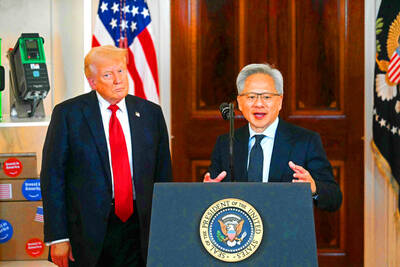Sony Corp more than doubled its annual loss forecast to ¥220 billion (US$2.9 billion), underscoring the challenge for incoming chief executive officer Kazuo Hirai in reviving Japan’s biggest consumer-electronics exporter.
The company blamed a stronger yen, cuts in production caused by last year’s Thailand floods and the cost of exiting a display-panel venture with Samsung Electronics Co for raising its November forecast for losing ¥90 billion. The loss in the 12 months ending next month will be the fourth in a row, a first since the Tokyo-based company was listed in 1958.
Sony, which yesterday named Hirai to replace Howard Stringer starting on April 1, cut sales targets for cameras, personal computers and PlayStation 3 game consoles, and said its mobile-phone unit performed worse than expected. The company posted a third-quarter net loss of ¥159 billion, compared with the ¥43 billion average loss of four analysts’ estimates compiled by Bloomberg.
“Sony is a very weak company,” said Edwin Merner, president of Atlantis Investment Research in Tokyo, who manages US$300 million and does not hold Sony shares. “To turn around at this time will be very, very difficult. As they go downhill, they pick up speed.”
It maintained its target for selling 20 million televisions, though the business may lose between ¥220 billion and ¥230 billion, including the cost of exiting the venture with Samsung, chief financial officer Masaru Kato said yesterday. That -compares with a November forecast for a ¥175 billion loss and adds to the ¥480 billion in losses since 2004.
Sony, maker of the Bravia model, has lost ground to Samsung and LG Electronics Inc, both of which sell TVs profitably. Sony and fellow Japanese television makers Sharp Corp and Panasonic Corp have been crippled by the strengthening yen, which forced Sharp to predict a record US$3.8 billion loss yesterday.
Sony dropped 2.6 percent to close at ¥1,328 in Tokyo trading yesterday, before the announcement. The stock has plunged 53 percent in the past 12 months, compared with an 18 percent drop for the broader TOPIX. Sony slid by more than 60 percent since Stringer, 69, took the helm in June 2005.
Hirai, 51, will succeed Stringer, who will become chairman of the board after a shareholders meeting in June, the company said in a statement on Wednesday. Hirai, who worked in the company’s music and entertainment divisions, established his reputation by turning around the PlayStation unit and edged out three other candidates with engineering backgrounds for the top job.
The company yesterday cut sales targets for the PlayStation 3 to 14 million units from 15 million. Hirai said recently the PlayStation 3 would have a 10-year lifespan, suggesting the five-year-old player will not be replaced soon.
Sony also cut its sales target for cameras to 21 million units from 23 million and reduced its forecast for personal-computer sales to 8.4 million from 9.4 million. Camcorder and Blu-ray disc sales also should be lower than projected, the company said.
The impact from Thailand’s worst floods in 70 years is estimated at ¥45 billion, while the appreciating yen will hurt profit by as much as ¥20 billion, Kato said. An appreciating yen damps the repatriated value of Sony’s overseas sales, while a weakening won inflates Samsung and LG.
Sony’s rating was cut by Moody’s Investors Service last month and Fitch Ratings in December, with both citing the difficulty of turning around the TV operations. Moody’s, which assigned a negative outlook to Sony, also downgraded Panasonic Corp’s rating.
Sony has unveiled new tablets, cameras and handheld game players to take on Apple Inc and try to revive profit. It also bought out partner Ericsson AB’s stake in their mobile-phone partnership.
In December, Sony introduced its latest handheld device, the PlayStation Vita, in Japan. Sales reached 500,000 units during the first three weeks, Hirai said last month. The product will be offered in the Americas and Europe starting on Feb. 22.

Taiwan Semiconductor Manufacturing Co (TSMC, 台積電) last week recorded an increase in the number of shareholders to the highest in almost eight months, despite its share price falling 3.38 percent from the previous week, Taiwan Stock Exchange data released on Saturday showed. As of Friday, TSMC had 1.88 million shareholders, the most since the week of April 25 and an increase of 31,870 from the previous week, the data showed. The number of shareholders jumped despite a drop of NT$50 (US$1.59), or 3.38 percent, in TSMC’s share price from a week earlier to NT$1,430, as investors took profits from their earlier gains

AI TALENT: No financial details were released about the deal, in which top Groq executives, including its CEO, would join Nvidia to help advance the technology Nvidia Corp has agreed to a licensing deal with artificial intelligence (AI) start-up Groq, furthering its investments in companies connected to the AI boom and gaining the right to add a new type of technology to its products. The world’s largest publicly traded company has paid for the right to use Groq’s technology and is to integrate its chip design into future products. Some of the start-up’s executives are leaving to join Nvidia to help with that effort, the companies said. Groq would continue as an independent company with a new chief executive, it said on Wednesday in a post on its Web

CHINA RIVAL: The chips are positioned to compete with Nvidia’s Hopper and Blackwell products and would enable clusters connecting more than 100,000 chips Moore Threads Technology Co (摩爾線程) introduced a new generation of chips aimed at reducing artificial intelligence (AI) developers’ dependence on Nvidia Corp’s hardware, just weeks after pulling off one of the most successful Chinese initial public offerings (IPOs) in years. “These products will significantly enhance world-class computing speed and capabilities that all developers aspire to,” Moore Threads CEO Zhang Jianzhong (張建中), a former Nvidia executive, said on Saturday at a company event in Beijing. “We hope they can meet the needs of more developers in China so that you no longer need to wait for advanced foreign products.” Chinese chipmakers are in

POLICY REVERSAL: The decision to allow sales of Nvidia’s H200 chips to China came after years of tightening controls and has drawn objections among some Republicans US House Republicans are calling for arms-sale-style congressional oversight of artificial intelligence (AI) chip exports as US President Donald Trump’s administration moves to approve licenses for Nvidia Corp to ship its H200 processor to China. US Representative Brian Mast, the Republican chairman of the US House Committee on Foreign Affairs, which oversees export controls, on Friday introduced a bill dubbed the AI Overwatch Act that would require the US Congress to be notified of AI chips sales to adversaries. Any processors equal to or higher in capabilities than Nvidia’s H20 would be subject to oversight, the draft bill says. Lawmakers would have